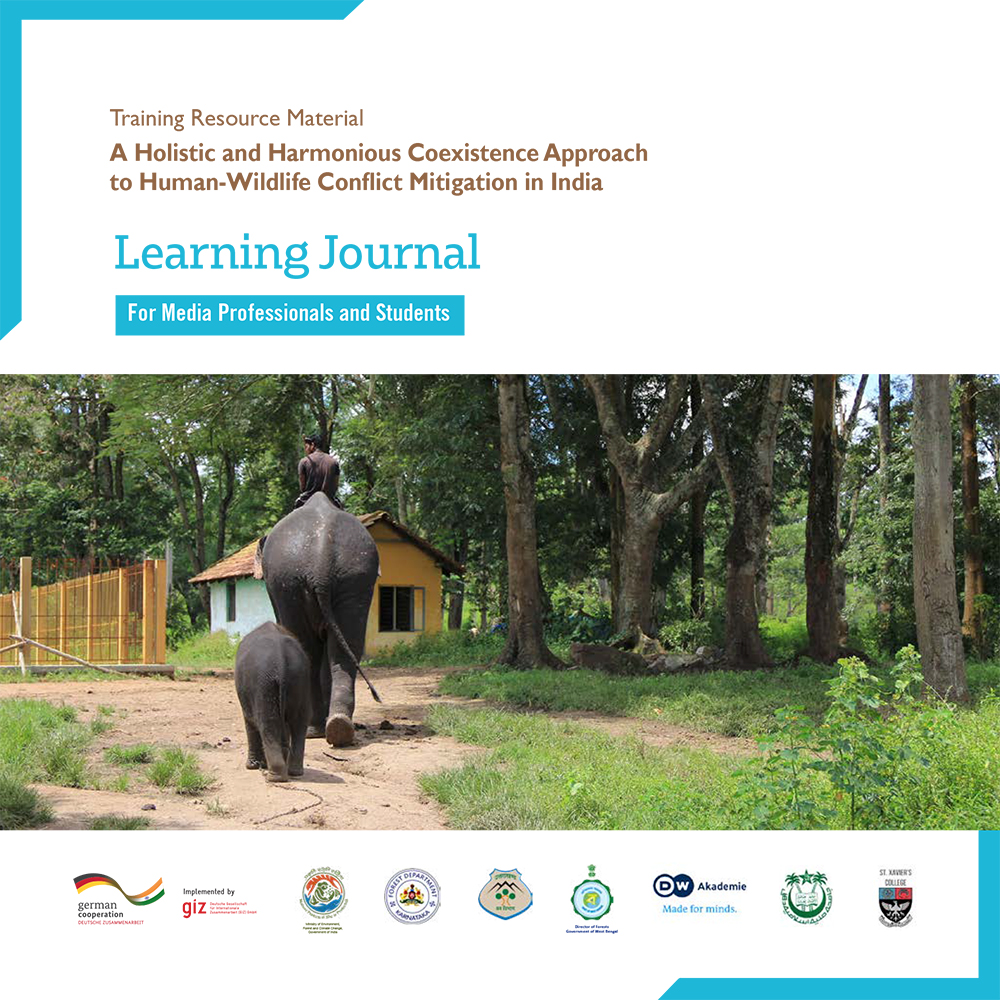'HWC mitigation' refers to the interventions carried out to reduce the negative impacts of human– wildlife interactions on humans or their resources and on wildlife or habitats. It includes strategies to address the drivers and pressures of conflict, reduce the vulnerability of humans and wildlife and develop institutional capacity.
Effective and clear communication, adopting a holistic approach, is critical for ensuring overall success in HWC mitigation. A systematic plan for conducting training programmes and organising dialogues for practicing media professionals is critical in bringing change and ensuring community participation in HWC mitigation efforts.
Facilitating media training institutions to integrate human–wildlife conflict mitigation into their curricula and equip the faculty members and trainers with the latest and innovative training approaches and methodologies is a sustainable option.
A holistic capacity development system needs to be implemented for addressing key competencies of relevant stakeholders, who are key to developing, implementing and communicating HWC mitigation measures in India.
The curriculum is modularised, with modules being delivered using different training methods over required time periods. The modularised structure provides flexibility to adapt the contents, methods and durations of different topics on the basis of the training needs of the participants. Learning outcomes have been formulated for different groups of participants, and so the modules can be used in any combination and over different durations, for specific purposes and to fit specific training schedules.
A unique feature of the curriculum is that it focuses on HWC using the "thematic triangle" of driver-prevention– damage reduction.
There are some common modules for all key stakeholders. These cover common issues and the basics of HWC. Specialized modules have been developed to deepen the understanding and skills of different training groups in their respective fields.
The curriculum uses a mix of conceptual and hands-on training sessions, in almost equal proportions, to facilitate the application of conceptual knowledge and skills to field conditions and the appreciation and understanding of the issue of HWC in a larger development context by the participants.
The Trainer's Toolkit is useful for the faculty members and experts of media training institutes, as well as media professionals, facilitating workshop/training sessions. This kit contains all the modules, the learning journal and a trainer's guide.
.jpg)
Trainer’s Guide: A Participatory Approach to Planning and Implementing Trainings on Human-Wildlife Conflict Mitigation in India (2023)
This trainer’s Guide facilitates the trainers and faculty members of trainings institutions of forest-wildlife, agriculture-veterinary, public health, media, rural development and Panchayati Raj and other relevant sectors in planning, implementing and updating the trainings on a holistic approach to HWC mitigation effectively through enhanced learning of the participants.
The Trainer’s Guide contains notes that provide details on the competency framework, and competencies-based training curriculum for key actors and stakeholders, provides sample training plans to implement the curriculum, and a detailed section to facilitate the use of participatory training methods.
The guide also serves as a compendium of selected participatory training methods, which are innovative, have been tested for their effectiveness, and are easy to be applied. The training methods can be customised to suit the learning objectives, audience, time availability, resource availability and other factors. It is also possible to include new case studies, relevant reading material or training activities as they become available. This guide provides general notes on planning, implementing and evaluating participatory trainings on ‘A Holistic Approach to HWC Mitigation in India’, and ‘Taking a One Health Approach to HWC Mitigation in India’ and specific tools for target-group-specific trainings for participants from, agriculture, media, community-institutions and field response teams. To access the Trainer’s Guide, Click here

Content modules, or Training Resource Material contain modules that will facilitate both trainers and participants in receiving background information on the training topics, apart from a field manual that will specifically be used by front-line staff.
To access the Training Resource Material, Click here

Learning Journal for Media Professionals and students, To facilitate the participant’s learning during and after the training, a learning journal is designed to help them capture anything that is of any significance or value to them and may help in enhancing their understanding of the HWC Mitigation and One Health concept, in general, and its application in the field, in particular. It is a place for participants to take notes on their observations on people, animals, systems, environment, and processes during the training.
To access the Learning Journal for Media Professionals and students, Click here
© 2014 IGBP. All Rights Reserved.
Site By: Virtualpages
